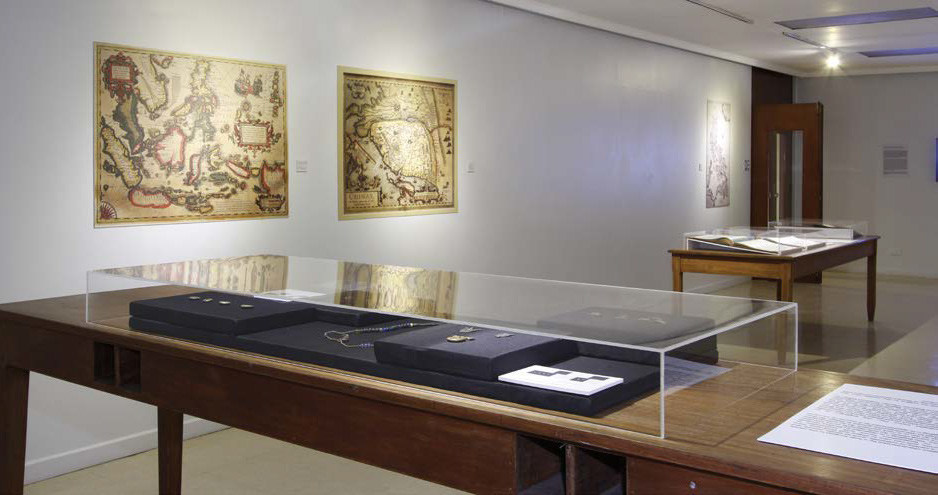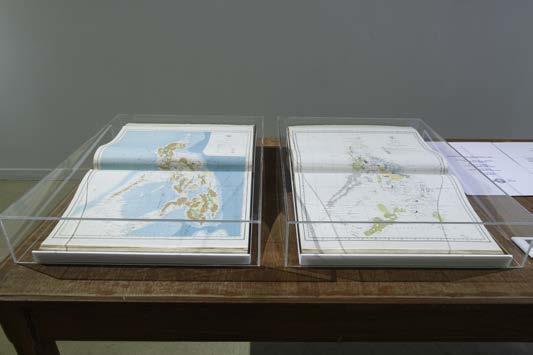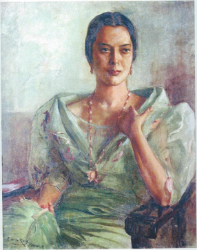
The restaging of the Philippine Pavilion for the 56th Venice Biennale at the Vargas Museum never aims for anything less than grand statements. After five decades of hiatus the country named after the king of Spain is back with an exhibition keen on “risks to make claims on currently contested world” writes Patrick Flores the curator of the exhibition. The curatorial argument arrive fully formed with old age museum strategies that draw from the mannaof Manuel Conde and Carlos Francisco’s 1950 film Genghis Khan as a pivotal point in telling the story of the present-future disputewith China over maritime boundaries. In the film, the protagonistpromised his lover that he would tie a string around the world and lay it at her feet as a token of incredible affection. Thecurator’s sophisticated weaving of the narrative film as an adageto contemporary Filipino geopolitics merges like a quirky electro- pop ballad that would have been otherwise awkward since those two are not really the most reliable and sync-able metaphors that fall under the contemporary curatorial art umbrella. It’s a good starting point for Flores, but it’s also the Achilles heel of his curatorial proposal.

All the same, there is a sincere charm to the whole Manuel Conde reference and without it, there is no way that Manny Montelibano’s 3-channel video installation titled Dashed States would have as much heft in depicting the contested Spratly Islands brimming with documents of real life situation and anthropology. Montelibano weaves a captivating imagery of the sea and its inhabitants that easily cut through the biscotti muzak, exemplified by the ornate heart-tugger editing of the videos that grips and arrests like a child on LSD. The drunken quality and the ambient street noise of the work fills the darkened room with skittering beats that evoke and transports one to the scene of the crime.
The same sense of place is also crucial to Jose Tence Ruiz’s installation titled Shoal that alludes to the repurposed World War II ship turned into a slum fortress hovering in the contested waters of the South China Sea. Ruiz adorns the ship in maroon velvet that reeks of claustrophobia for one needs to pass through with back etched on the wall like a calculating ninja. An allusion perhaps to China’s feverish closing-in to territories they claim to be theirs.
Tie A String Around the World ambles effortlessly for its curatorial palette is wide enough to stave off repetition yet innate enough to offer intense cohesion. The off-the-cuff production and non-fat storytelling is likely linked to the curators’ brevity and research – the works interact with each other like conversations between lovers that dovetails with obsession and harmony. The pairing of the two different generations of artists seems a bit forced although one can argue that the points of comparison are contemporary and complementary. It is so timelythat it offers fleeting touches of Philippine modernity without overbearing onthe makeshift hours of poverty porn and all the subtle accouterments that comewith it. Instead, the exhibition relies on a modest refinement that you can read onrecent writings on the curatorial in lieu of arrangement, discourse, and politics. It felt like an orthodox museum show but still carries a guileless refreshing charm.The homage to Conde’s film as the premise of the whole exhibition felt like an ostentatious insider strategy that cripples the infinite ambition of the pavilionfor it doesn’t really provide the audience a writ of easy access to the Philippine imagination if you are not from the region. Also, one can easily get lost in the impenetrable metaphor of world making that somewhat translates to a snarky nationalistic agenda of vying for global sympathy on a regional territorial dispute.

The exhibition strikes like a cry for help, a need to trigger a reaction and maybe that was the point. China is a bully and we need to chastise the dragon within an international tribunal at The Hague. But it’s hard to have an argument with only one person in the room. The exhibition could have had hammered the argument clearer if there was some artistic rumination of exchanges and dialogues between the countries that are currently in dispute in the contested reefs and islands of the South East. Rather, the pavilion resorted to an Appalachian strategy of averbal and non-verbal artistic gymnastics of fleshing out the national agenda. Itis after all still a national pavilion with nationalistic interests.
At the heart of the exhibition is a very potent argument in all fronts - the constant reshaping of territories around the globe wedded with the mining of different versions of modernities of the deep past and the here and now will probably make people feel slightly more intelligent and globally aware from when they arrived and maybe after seeing the show ask themselves. Now, what do we do? Here’s a suggestion: Let the string cook in your mind’s eye for a while and remember the current map of the world for this will be part of history in all the worlds futures and while you’re at it, lay the map on a table and tie a string but cut it right in the middle.





